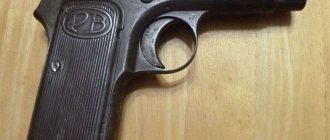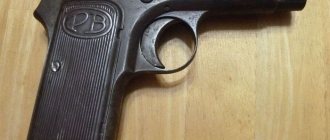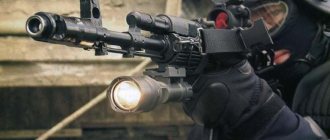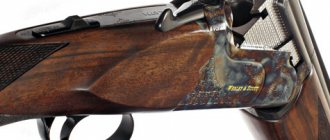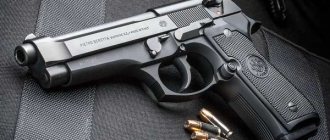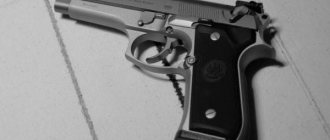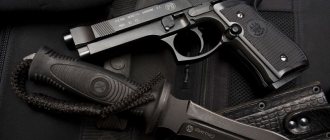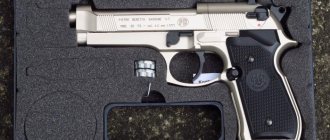In May 1915, Italy enters the First World War. In the first months, there is a need for reliable close combat weapons - pistols. The Glisenti M 1910 pistol, similar to the German parabellum, did not satisfy this need. Then Pietro Beretta comes onto the scene with its own take on the design of a pistol.
This is the look of the 9 mm M1915 model, which quickly replaced all analogues and won a place in the holster of the Italian army. The accuracy and reliability of the new weapon, which made history at the right moment, ensured the future of Beretta pistols for a long time.
Thus began the history of the family of Italian self-loading pistols, which has continued for more than a hundred years.
One Hundred Years of History
1915–1951
Model M1915 was chambered for 9x19 mm Glisenti caliber. Two years later, a lightweight M1917 of a weaker caliber appeared, with a 7.65x17 mm Browning cartridge. In 1923, the 9x19mm Glisenti became the main cartridge. In the same year, Pietro Beretta released a new prototype - Beretta M1923 for this cartridge.
This model was in service until 1935, and in minor roles until 1945.
It was characterized by low reliability and less destructive power compared to pistols for 9x19 Parabellum. Production ceased in 1925.
The Beretta M1934 replaced its outdated predecessors in 1935. It was produced in 9 mm (Corto) and 7.65 mm cartridges. The 7.65 model lasted in production from 1935 to 1991.
In fact, production ended in 1980, but in 1991 a collector's batch of these weapons was released. It entered service with the Third Reich under the name Pistole 671. It was used by officers of Romania and Finland during World War II.
1951–1980
The M1934/1935 is being replaced by the Beretta M1951 with the Parabellum 9 mm caliber, the development of which began in the 40s.
The creation of the pistol was led by the need to standardize NATO weapons and the ability to use submachine gun cartridges. Production from 1953 to 1980.
Due to its large mass (870 grams without magazine), the weapon quickly returned to the aiming line after recoil. Convenient to use.
For the first time, the weapon shows Italian design, compared to the boring and unremarkable previous designs.
In the mid-70s, Italian craftsmen took all the best from the previous family of pistols and created a new weapon - the Beretta 92.
For the first time, the index 92 does not indicate the year of production: 92 is 9 mm, 2nd model. Apparently, the first model was being developed, which did not suit its creators.
Produced from '75 to '80. The modification came off the assembly line in quantities of 5 thousand pieces, using the same 9 mm parabellums.
A plant was built in Brazil to manufacture this model, which was later sold to Taurus.
After this, the production of weapons began under the name PT 92. In turn, the Beretta 92 and PT 92 models had a lot in common in appearance, but were structurally different.
Taurus also released a wide range of pistols under the PT brand.
1980–today
In the late 70s, the Beretta 92S completely replaced the original 92 version. This pistol met the wishes of the Italian police for service equipment.
From 1978 to 1984, Pietro Beretta took part in an American tender for a company that would supply new pistols to the US Army.
In addition to the Italian manufacturer, Americans, Germans, Spaniards, Belgians and Swiss participated.
The leading pistols were the Beretta 92F and the Swiss Sig Sauer P226. Beretta won this competition, surpassing its competitor in the purchase price.
And according to the unofficial version, for political reasons between Italy and the United States, perhaps for granting the right to deploy bases and missile defense on their territory.
One way or another, the company received the first contract for 500,000 weapons under the M9 brand (Beretta 92F). The production of weapons began at its own branch in the USA, Maryland.
From the 80s to this day, the manufacturer has been producing a wide range of pistols in the 92 line.
The Beretta 92 pistol is the best in the Beretta family.
The Beretta 92 pistol was recognized (and still is) as the best version of the weapon. Actually, we are not even talking about a single version, but about a whole family of pistols called Beretta 92. Subsequently, this type of pistol was repeatedly modified and improved and, accordingly, various letters, numbers and other symbols were added to its original name.
For example, the US Army was armed with the Beretta 92F pistol with a 9 mm caliber; the pistol was then called the M9. The pistol entered the American army with a variety of accessories - in particular, a silencer and a flame extinguisher. Subsequently, this version of the pistol underwent additional improvements.
It is very difficult to list all the modifications of the Beretta 92, since there are currently more than 150 of them. And these are only the official modified versions, but, as already mentioned, there are also unofficial versions.
Thus, in a separate article we can talk about only some of the most popular modifications of the Beretta 92:
- Beretta 92S. This is the so-called “police pistol” that the Italian police are armed with. Compared to the classic Beretta 92, this version of the pistol has the safety on the slide rather than on the frame. When the safety is turned on, the trigger, in turn, is released from the cocking position without any danger, while the firing pin is blocked, and the trigger rod cannot come into contact with the sear. However, in this state it is possible to open the shutter, although the trigger itself will not be cocked, but will remain deflated;
- Beretta 92SB. This version was used for a long time in the US Army and partially in the armies of some Western countries. The fuse in this version of the weapon disconnected the sear from the trigger rod. When the safety was engaged, the trigger could still move, but was separated from the firing pin by a jumper. In addition, the button with which the magazine is ejected was removed from the bottom of the handle and installed in its middle - moreover, it could be either on the right or on the left (for right-handed and left-handed people). For the same purpose, fuse boxes were also installed on both sides of the bolt. This made it possible to fire from both the left and right hands. The magazine capacity was 13 charges, caliber - 9 mm. Currently, this version has been replaced by another with more advanced automation;
- Beretta 92F. The difference between this model and others was that its components were redesigned. This was done for a dual purpose: to improve the interchangeability of one model with others, and also to simplify mass production. Initially, this type of pistol was intended for government members and other high-ranking persons. The trigger guard in the pistol was changed so that the weapon could be held with both hands, the angle of the handle was also changed, the barrel was chromed, and the body was coated with a special compound to protect against rust;
- Beretta 92FS. American military personnel are still armed with this type of weapon. The design of this type of pistol is almost indistinguishable from the Beretta 92F, with the exception of a small disk located on the head of the trigger axis, as well as a special longitudinal groove located at the lower left edge of the bolt. The purpose of the disc is to prevent the back of the bolt from coming off if it is destroyed;
- Beretta 90-Two. Relatively recent version (2006). The sample has improved ergonomic properties and has a more modern design. The pistol of this version is most convenient to remove from a holster or pocket due to the fact that all its sharp protrusions are smoothed;
- Beretta 93R. This version of the pistol can be fired in short (fixed) bursts.
Design features of the Beretta 92
The safety lever is double-sided and is located on the bolt cover. Turned on with your thumbs by turning the flag down.
The included safety does not block the bolt, which allows you to safely reload the weapon. When the safety is turned on, the trigger is disconnected from the trigger rod - that is, it becomes uncocked.
You don't have to cock the hammer before firing, but you will need to put more force on the trigger than when it was cocked. This is called self-cocking.
There is a jumper between the cartridge primer and the firing pin, which prevents a shot until the last phase of the trigger movement. Immediately before the shot, this jumper rises.
After the clip is used up, the bolt casing is retracted and locked in this position. When a full magazine is loaded, the bolt automatically fires a cartridge into the chamber.
Modifications based on the Beretta 92
- Beretta 92S modified for the needs of the Italian police. The safety has also been modified for the role of a safe release of the trigger (release without firing a shot on the safety). Today, clips suitable for this model are produced. Produced since 1976. Currently out of print;
- The Beretta 92SB is a continuation of the previous model. The main differences are the double-sided safety and automatic firing pin locking. Magazine for 15 rounds. Produced from 1981 to 1991;
- The Beretta 92F appeared to participate in the XM9 tender, as a replacement for the main pistol of the US armed forces. After the victory, production began under the designation M9. Produced since 1984;
- The Beretta 92G Gendarmerie is produced in France under the designation PAMAS G1. The appearance is due to the replacement of outdated pistols for the needs of French police. Produced since 1987;
- Beretta 92FS is a modification of the American 92F. Put into production to eliminate errors of the previous model 92F, based on the combat experience of the American military: the bolt was sometimes destroyed during use. Produced since 1989 (for American aircraft under the name M9);
- Beretta 92D without safety. Produced since 1990;
- Beretta 96 is a modification of the 92F chambered for the common American .40 SW cartridge. Used by US police and border guards, popular among civilians. Magazine for 11 rounds. Produced since 1992;
- Beretta 96 Brigadier - modification 92FS chambered for .40 SW with a reinforced bolt, removable front sight. Produced since 1996;
- Beretta 92FS Centurion. Double-row magazine for 15 rounds. Shortened, both the barrel and the bolt are on an unchanged frame. Produced since 1996;
- The Beretta 92 Vertec was originally intended for US police. Changes to the handle to make it easier for a larger person to hold. Mount for laser laser or flashlight. Produced since 2003;
- The Beretta 90 Two is the latest example in the 92 line. It has the ability to use an under-barrel flashlight or a laser target designator. Futuristic design solutions have been introduced to the exterior. Produced since 2006.
In addition to these samples, there is the Beretta 98 line (7.65x21 mm Parabellum) and its variants chambered for 9x21 mm IMI cartridges. This line is for countries, mainly European, where military calibers are prohibited for civilian use.
One of the most popular souvenirs that Allied soldiers brought back from the European continent during World War II were Italian 9mm Beretta automatic pistols.
Despite the fact that the Beretta arms company may well lay claim to the title of the oldest arms manufacturer in the world, its name became known to everyone only in 1985, when it won a competition to arm the American army with its new pistols.
The Italian factory d'Armi Pietro Beretta is one of the oldest arms companies in Europe. The company has long been known for its hunting and sporting weapons. But, perhaps, it was the self-loading pistols that brought it the greatest fame, which Pietro Beretta, sensing the situation, took up during the First World War, or more precisely in 1915.
Due to hostilities in Europe, the company had to develop a small, 7.65 mm Beretta blowback pistol . Subsequently, it was modified and became the famous 34th model and thus a weapons souvenir for the military after the end of the Second World War.
In 1938, the Beretta arms company entered into a lucrative deal with the Japanese government to supply rifles for the needs of the Imperial Japanese Army. Deliveries took place until 1942 and in total about 120 thousand rifles were produced and sent to Japan.
During World War II, Beretta factories produced pistols, rifles, and submachine guns for the needs of the Italian army until the surrender of Italy in 1943. However, even after the surrender of Italy, the production of weapons at Beretta factories did not stop. Northern Italy, where the main workshops of the company were located, remained in the hands of Germany, where weapons for the Third Reich were assembled.
The quality and processing of weapons produced during the war were much worse than those of the same models produced before the outbreak of hostilities. However, all Berettas, regardless of the year of manufacture, were reliable and highly valued in the armies of Germany, Italy and Japan.
After the end of World War II, the owners of the Beretta company were engaged in repairing American weapons, in particular the M1 Garand rifles. At one time, Beretta even produced its own modified version of the M1 "Garand" rifle, the Beretta M1-59. Moreover, according to experts, the Italian version of the American rifle was more accurate and reliable.
For many years, the Beretta pistol had a relatively simple automation scheme based on the blowback feed, but restoring production after the war, the company, which always followed other people’s experience, decided to produce for the Italian army a heavier and more reliable weapon with a locking bolt and with the ability to use a 9 mm cartridge of the type "Parabellum". In 1950, gunsmiths design the Beretta 951 pistol .
One of the most distinctive parts of the Beretta pistol is the cutout of the top of the bolt housing. If in other models of pistols the casing completely covered the barrel, in the Beretta pistol there is a cutout from the front sight to the bolt - this is a fail-safe solution for ejecting spent cartridges. But with such a cutout it is impossible to accommodate a locking bolt, which depends on the connection of the movable bolt casing with a short-stroke barrel, such as in Colt or Browning self-loading pistols. Therefore, in its new 951 model, Beretta was forced to use a new method of locking the bolt.
The system chosen was similar to that used in the Walter P-38. The locking wedge is located under the barrel, which is connected to the bolt housing in the closed position. Such a system is quite suitable for a powerful cartridge. In addition, the Beretta pistol has a number of other positive qualities, such as holding the bolt housing in the rear position after the last shot and a double-sided safety flag on the frame.
In the early 70s of the last century, Beretta began producing pistols with a double-action trigger mechanism for police officers and athletes. It all started with the production of the 7.65 mm Beretta pistol of the 81st model, which subsequently had several modifications.
Then, having worked out manufacturing technology and new design solutions on the example of commercial models, Beretta again began producing weapons for the army. So in 1976, the Beretta 92nd model pistol was born.
The Beretta 92 pistol consists of seven main parts: a frame, a barrel, a bolt casing with a firing pin, ejector and sights, a barrel lock, a trigger mechanism, a return mechanism, and a magazine.
The most noticeable change in the pistol is the enlargement of the trigger guard and the movement of the trigger forward. On the left side of the Beretta 92 there is a bolt housing delay that keeps it in the rear position after the last shot. To close the casing, press the delay button. There is also a fuse on the left side. The double-stack magazine holds 15 rounds and has a slot at the back through which you can see how many rounds are left.
Then the factory released the 92S model. On the Beretta 92 S , the safety box was moved from the frame to the casing, connecting the safety to the firing mechanism so that the safety began to block the firing pin, allowing the trigger to move freely. This ensured safety in handling the pistol in case it was dropped or needed to be carried in a holster loaded.
To put the gun into working condition, you need to remove it from the safety catch. When you press the trigger, the hammer cocks, and then turns, hitting the firing pin.
The 92S was immediately followed by the 92SB modification, in which the fuse is located on both the left and right sides of the casing. For left and right hands. In addition, the magazine latch was moved from the bottom of the handle to the level of the trigger guard. Now you could use it with the hand with which you shoot. Which is important for lefties.
The safety mechanism has also been improved. Now, when turned on, it disconnected the trigger from the hammer and more reliably blocked the striker, which was only activated when the trigger was fully pressed. Thus, a shot is fired only when properly prepared for shooting, which completely eliminates the possibility of accidental shots during a fall or impact.
The Beretta 92 SB became a shortened modification with a total length of 197 mm. and barrel length 135 mm.
In the mid-70s of the last century, the American army announced a competition for a new pistol, which had the following requirements: the pistol must have a double-action trigger mechanism, allow the use of a 9mm Parabellum cartridge, and also allow the use of a safety lock and the magazine latch with both hands.
In response to this, Beretta developed the Beretta 92F. In size and principle of operation, this model was similar to the 92SB, but a special protrusion was made on the trigger guard so that the pistol could be held with two hands. With a safety button and a magazine release, you can also use it with both hands. The handle received a small protrusion in the lower front part and new linings. The inside of the barrel was chromed. And the outside of the gun was coated with an anti-corrosion material like Teflon.
When firing the first shot from the 92nd model by self-cocking, the mechanism works as follows: when you press the trigger, the trigger rod hook grabs the trigger protrusion and turns it, compressing the mainspring. The frame cutout does not allow the rod hook to rise. Therefore, the protrusion of the trigger breaks off the hook - the trigger hits the firing pin.
After the shot, the coupled barrel and bolt move back to a length of approximately 8 mm. After which, a special, spring-loaded rod is retracted into the frame, stops and relatively smoothly presses the larva down. It lowers, disengages the bolt from the barrel and stops it. The bolt continues to move backward, compressing the return spring located under the barrel, extracting and removing the spent cartridge case outside the pistol. By pressing the protrusion of the trigger rod, it presses it down, disconnecting it from the trigger and sear.
The frame stop serves as a limiter for the rearward movement of the shutter housing. Under the action of the return spring, the bolt casing moves forward, picks up the next cartridge from the clip, sends it into the chamber, after which the entire movable system - the bolt with the barrel - moves forward. The larva, with its front bevel, runs onto the bevel of the frame, rises and engages the bolt with the barrel. The moving system stops when the barrel rests against the lock. The trigger remains cocked, resting its combat cock on the spring-loaded sear. The trigger returns forward. The gun is ready for the next shot.
The next time you press the trigger, the trigger rod hook deflects the sear forward, removing it from under the cocking action.
A significant step for the Beretta 92F pistol was the introduction of a double-row, increased-capacity magazine with a staggered arrangement of 15 rounds. The magazine release is located at the bottom of the handle. When the cartridges are used up, the feeder turns on the slide stop.
The next step, Italian gunsmiths release the Beretta 92F Compact , a shortened version of the basic model.
the Beretta 92 SB - C model was released , in which instead of a 15-round magazine, it was equipped with a single-row magazine for 8 rounds.
This model began to be used mainly among security guards and police.
The scale of Beretta's success can be appreciated. Only the initial order for the new pistol, designated M9, amounted to 315 thousand, which the company was supposed to deliver to the United States within five years, starting in January 1987.
This Beretta model, in addition to excellent performance, also had improved combat characteristics. High muzzle energy of 500 J. Significant stopping and penetrating effect of the bullet. The shape of the angle and inclination of the pistol grip ensured ease of aiming and shooting with both hands offhand. A long sighting line and a relatively soft trigger, along with successful balancing, determined good accuracy and accuracy of fire.
On of Beretta M9 pistols , there were cases of cracks appearing on the bolt when firing. This required improving the quality of the metal and improving manufacturing processes.
In 1990, the Beretta 92 FS with an extended trigger axis and longitudinal grooves on the inner surfaces of the bolt casing went into production.
When the bolt moved backward, the front edges of the sharpening points rested against the ends of the trigger axis and slowed down the bolt, softening its impact on the frame in the rear position. As a result, prototypes of the next batches of pistols could withstand up to 30 thousand shots. The complaints stopped.
3 years after the adoption of the Beretta M9 pistol, in August 1988, three pistols were tested: Beretta M9, Smith & Wesson M5904 and Ruger P85. The winner was 9 mm. Beretta M9 pistol .
The M9 pistols showed themselves during the fighting in the Persian Gulf as a reliable and easy-to-handle self-defense weapon, fully justifying the hopes placed on them.
The 92nd Beretta has two dozen modifications. This is perhaps the richest family of all combat pistols of the last quarter of the last century. A relatively powerful cartridge, about 14 gauge, a long barrel, good balance - give the pistol good ballistics. It is worth noting that noticeable weight also plays a role in the accuracy of the Beretta.
On January 31, 2009, the Russian government expanded the list of weapons that Russian prosecutors and investigators are allowed to use for self-defense. The list has been expanded to include three 9mm semi-automatic models. Now prosecutors and investigators can arm themselves with Beretta 92 series pistols.
SEE: ALL GUNS OF OTHER BRANDS
Gyurza pistol (SPS) - characteristics, advantages, device
TT pistol - characteristics, advantages, device
Pros Cons
Advantages:
- Large balanced weight from 870 to 950 grams (up to 1000) leads to a quick return to the line of sight;
- The increased distance between the front sight and the sight makes aiming easier;
- The fuse box is located on both sides;
- “Licked” structural elements do not cling when pulled out.
Flaws:
- The immodest size makes concealed carry difficult;
- Firing high power cartridges reduces durability;
- The bulky handle is inconvenient for a person with small palms and fingers.
Since the pistol’s feature is an open bolt with a view of the barrel, the following disadvantages arise:
- Possibility of getting burned by a hot barrel;
- Increased contamination of the internal parts of the gun.
Today the Pietro Beretta company is called Fabbrica d'Armi Pietro Beretta Gardone and is not going to give up its place in the arms market, including pistols. The BU-9 Nano, an extremely compact concealed carry pistol, was recently released.
The latest development that has already appeared on the market is the Beretta APX multi-caliber pistol. The Beretta story definitely won’t end there, we’ll wait and see.
Tactical and technical description of the Beretta 92 pistol
The performance characteristics of this type of weapon are as follows:
- Country of issue – Italy;
- Charge caliber – 9 mm;
- Length (total) – 217 mm;
- Barrel length – 125 mm;
- Pistol weight – 980 g;
- Magazine capacity – 15 charges;
- Firing mode – automatic;
- The firing range with effective target destruction is 25 m.
It should be noted here: despite its externally standard design, the Beretta 92 is nevertheless one of the most reliable, and therefore the most sought-after examples of short-barreled weapons (pistols and revolvers) today.
